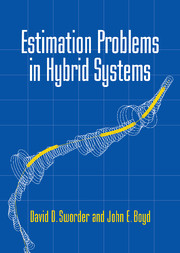Book contents
- Frontmatter
- Contents
- List of Illustrations
- Preface
- 1 Hybrid Estimation
- 2 The Polymorphic Estimator
- 3 Situation Assessment
- 4 Image-Enhanced Target Tracking
- 5 Hybrid Plants with Base-State Discontinuities
- 6 Mode-Dependent Observations
- 7 Control of Hybrid Systems
- 8 Target Recognition and Prediction
- 9 Hybrid Estimation Using Measure Changes
- Appendix 1 PME Derivation Details
- Appendix 2 COM Derivation Details
- Bibliography
- Index
- Glossary
Preface
Published online by Cambridge University Press: 17 August 2009
- Frontmatter
- Contents
- List of Illustrations
- Preface
- 1 Hybrid Estimation
- 2 The Polymorphic Estimator
- 3 Situation Assessment
- 4 Image-Enhanced Target Tracking
- 5 Hybrid Plants with Base-State Discontinuities
- 6 Mode-Dependent Observations
- 7 Control of Hybrid Systems
- 8 Target Recognition and Prediction
- 9 Hybrid Estimation Using Measure Changes
- Appendix 1 PME Derivation Details
- Appendix 2 COM Derivation Details
- Bibliography
- Index
- Glossary
Summary
Who Should Read This Book
This book is intended for engineers and designers who seek to develop effective estimation and control algorithms for nonlinear systems. The reader is assumed to have some background in random processes and estimation (see, for example, [Pap91]) along with familiarity with concepts of feedback control phrased within the context of linear state space models (see, for example, [DB95] or [Wo194]). This background should include knowledge of
random variables and processes,
probability density and distribution functions for random variables, both continuous and discrete,
moments and cross moments, including correlation functions,
second-order properties of stationary processes, including power spectral densities,
conditional expectations with respect to an observation process,
fundamental properties of feedback systems, including stability and controllability of a system model.
Both time-continuous and time-discrete processes will be encountered. Some familiarity with mean-square estimation is useful. For example, in the development of the Kalman filter [BW92, Chapter 7], linear state space models are integrated with Gaussian white noise. The Kalman filter will form a basis of comparison for many of the estimators that follow.
Our treatment is applications oriented, but the reader will find that nonlinear systems require more detailed analysis than is necessary in the study of linear systems.
- Type
- Chapter
- Information
- Estimation Problems in Hybrid Systems , pp. xiii - xxiiPublisher: Cambridge University PressPrint publication year: 1999

